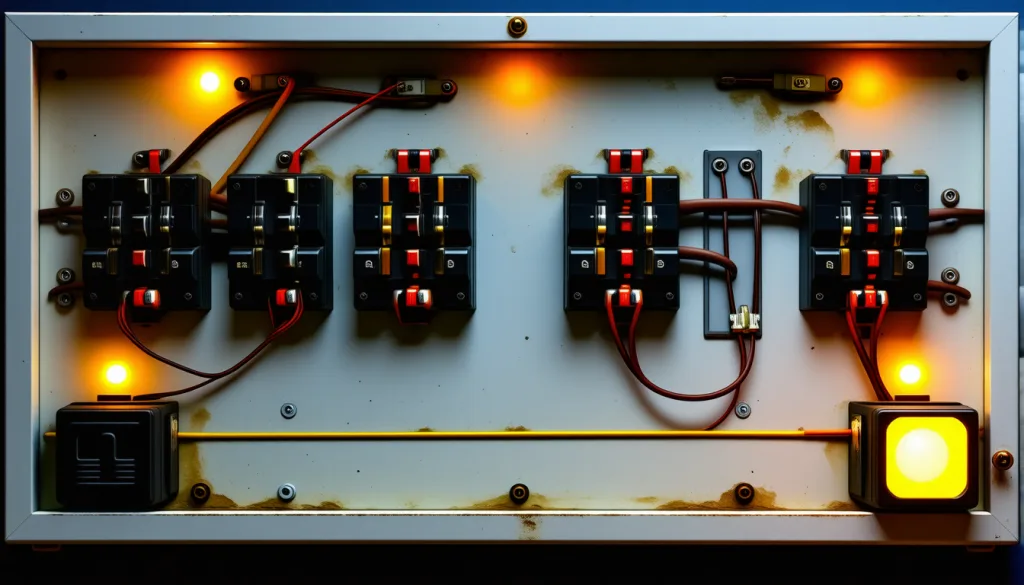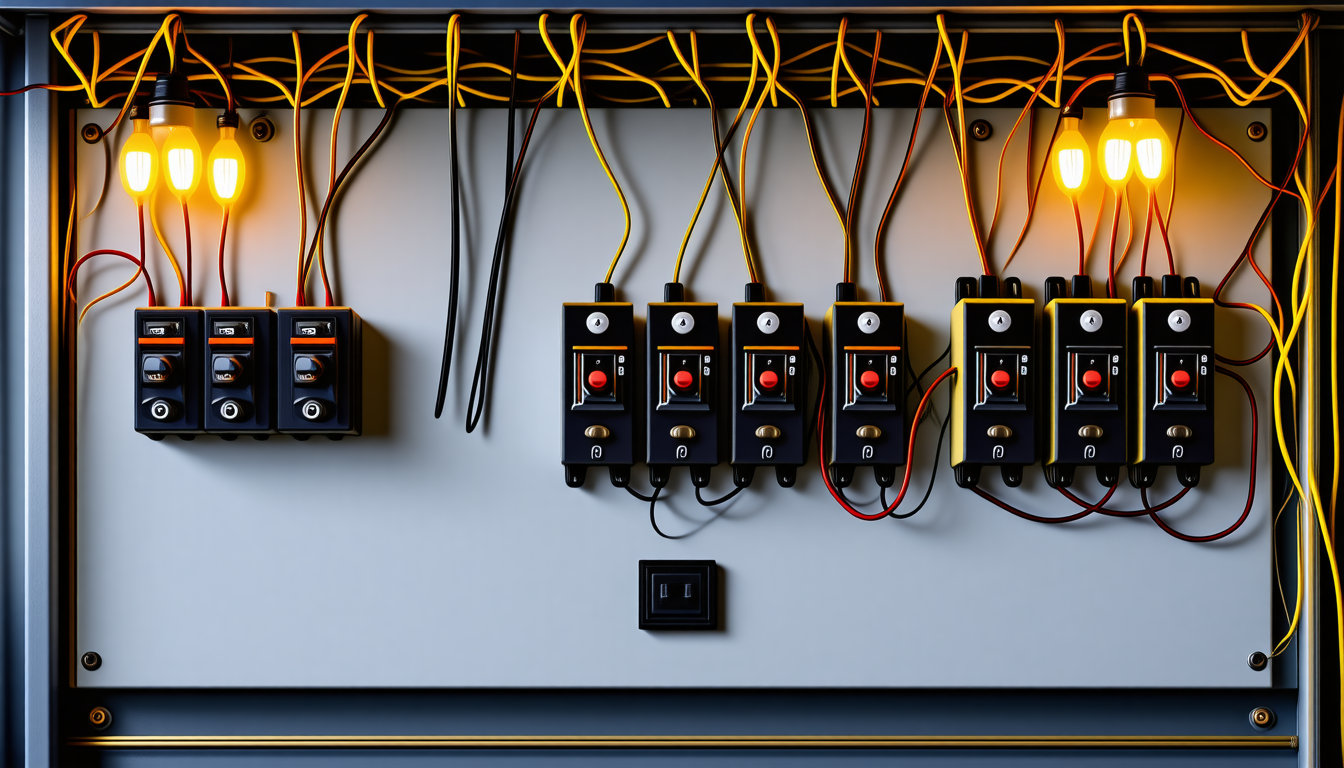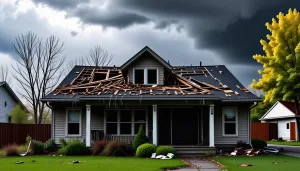The electrical panel serves as the central hub of your home’s electrical system, controlling the distribution of electricity throughout different rooms and circuits. Ensuring it is in optimal condition is crucial not only for the functionality of your electrical system but also for the safety of your home. Recognizing the signs that your electrical panel needs an upgrade can help you address potential issues before they escalate into more serious problems.
One of the most prevalent indicators that it may be time to upgrade your electrical panel is the age of the existing system. Most homes built more than 20–30 years ago may still have outdated electrical panels that were not designed to handle the modern-day electrical load. These panels can exhibit tell-tale signs like frequent circuit breaker trips, which occur when the system is overloaded and can lead to inconvenient and potentially dangerous power outages.
Sizzling or buzzing sounds coming from the panel are another significant warning sign. These noises may indicate that the wires are frayed, or the connections are loose, presenting a fire hazard. Similarly, if you find that the lights in your home flicker and dim unexpectedly, this could point to an insufficient power supply reaching your home’s circuits, indicating the need for an upgrade.
Homeowners undertaking significant home improvements or adding new appliances should also consider upgrading their electrical panel. Modern appliances demand more from your electrical system, and older panels may not support this increased load effectively. The constant use of power strips or extension cords to compensate for a lack of outlets can also be a clue that your panel can no longer keep up with your household’s needs.
- Frequent circuit breaker trips
- Unusual sounds from the panel such as sizzling or buzzing
- Flickering or dimming lights
- Reliance on extension cords and power strips
If you regularly experience any of these issues, it is advisable to consider assessing the adequacy of your current electrical panel with a professional. Upgrading your electrical panel isn’t merely about improving convenience; it’s a proactive measure for ensuring safety and efficiency in your home’s electrical system. Ultimately, recognizing and addressing these signs early can drastically enhance safety measures and potentially save you from costly repairs down the line.
factors influencing upgrade costs
A variety of factors can influence the total cost of upgrading an electrical panel, and understanding these can help homeowners budget effectively and make informed decisions. Here is a detailed look at some of the primary elements that contribute to the overall expense:
1. Panel Capacity: The capacity of the new electrical panel is a significant determinant of cost. Panels range from 100 amps to 400 amps, with the latter being more expensive. Larger capacity panels are typically necessary for homes with high electricity usage or significant home improvements, like installing new HVAC systems or large appliances.
2. Type of Panel: Different types of panels are available, such as main breaker panels or sub-panels. Main breaker panels, which handle the primary distribution of electricity throughout the home, generally cost more than sub-panels, which are used to extend power in specific areas of a home. Moreover, opting for modern, safety-enhanced panels may increase upfront costs but can offer better longevity and safety.
3. Labor Costs: The complexity and duration of the installation process can greatly affect labor expenses. Electricians charge based on their expertise, time required, and the intricacies involved in fitting a new panel. Homes with outdated wiring or hard-to-reach panel locations might encounter higher labor fees due to the extra work involved in ensuring the wiring is up to code and safely installed.
4. Permits and Inspections: Depending on local regulations, obtaining permits and passing inspections can add to the cost. Permits are essential to comply with safety standards, ensuring the installation meets local electrical codes. Inspections further verify compliance, safeguarding the homeowner and preventing potential legal issues.
5. Material and Equipment: Besides the panel itself, additional materials such as new wiring, breakers, and the panel box contribute to overall expenses. The quality and brand of these materials can also impact cost — high-end brands or advanced technology options usually come with a premium price.
6. Location and Accessibility: The location of the panel within the home can affect labor and material costs. Panels located in hard-to-access areas like cramped basements or attics might require more time and specialized tools, thereby increasing costs. Additionally, the complexity of rerouting wires to accommodate the new panel location affects material and labor costs.
7. Safety Upgrades: During an electrical panel upgrade, additional safety-related improvements might be necessary to ensure compliance with current codes, such as grounding systems or including advanced circuit breakers that add to the cost but enhance long-term safety.
8. Home Specific Considerations: Some homes may require unique updates due to their age, design, or previous renovations. Historical homes might face higher costs due to required customizations to preserve architectural integrity while meeting electrical safety standards.
By understanding these factors, homeowners can better navigate the electrical panel upgrade process, ensuring both their immediate and future electrical needs are effectively and safely met without unexpected financial surprises.
benefits of upgrading your electrical panel
When considering an upgrade to your electrical panel, the benefits extend beyond simply keeping up with increasing power demands and addressing safety concerns. One of the primary advantages is the enhanced safety that a new panel provides. Older panels may have frayed wires or poor connections, which could result in electrical fires. Modern panels are equipped with advanced technology and built-in safety features such as arc fault circuit interrupters (AFCIs) and ground fault circuit interrupters (GFCIs), significantly reducing the risk of electrical fires and shocks. This upgrade ensures your home is safeguarded against such hazards, providing you with peace of mind.
Another key benefit is the increased capacity and efficiency that comes with a modern electrical panel. Today’s homes rely on numerous gadgets, appliances, and smart devices, all of which demand a higher electrical load than older panels can supply. By installing a new panel with a higher amperage capacity, you effectively eliminate the inconvenience of frequent circuit breaker trips and ensure that your home’s electrical system can efficiently support your current and future needs. This is especially crucial if you are planning any home improvements, such as kitchen remodels or the addition of central air conditioning, which significantly increase power consumption.
In addition to safety and efficiency, upgrading your electrical panel can also increase your home's value. Future homebuyers often consider the state of a home’s electrical system as a critical factor in their purchasing decision. By investing in an electrical panel upgrade, you are demonstrating a commitment to maintaining the home’s infrastructure, appealing to potential buyers who appreciate the reduced risk and modern standards. This can potentially lead to a higher resale value and make your property more competitive in the market.
Moreover, a modern electrical panel enhances the reliability of your power supply. You eliminate the frustration of dealing with flickering lights or malfunctioning appliances, which can occur with outdated panels. By ensuring a consistent and stable electrical flow, you can enjoy the convenience of seamlessly operating multiple devices and systems simultaneously without performance issues.
Finally, opting for an electric panel upgrade promotes energy efficiency, as the latest panels are designed to distribute power more effectively, leading to potential energy savings over time. This aspect can lower your utility bills while simultaneously benefiting the environment by reducing your energy consumption footprint. Overall, the investment in an upgraded electrical panel not only enhances the safety and functionality of your home but can also provide long-term economic and environmental benefits.
typical costs for upgrading an electrical panel
When upgrading your electrical panel, navigating the costs involved is a critical part of the process. Typically, for a standard 200-amp panel upgrade, homeowners can expect to spend anywhere between $1,500 and $3,000. However, this range can vary significantly based on multiple factors specific to your home and needs. It’s important to remember that these costs not only cover the panel itself but also encompass labor, materials, permits, and any necessary home improvements to meet current safety standards.
For instance, if your home requires a larger capacity 400-amp panel to accommodate extensive electrical use, the cost could increase to between $2,000 and $4,000 or more. Factors such as the specific type of panel chosen — main breaker panels versus sub-panels — also influence the price. Main breaker panels tend to be on the higher end due to their central role in managing the home’s electricity distribution.
In addition, labor costs comprise a significant portion of the overall upgrade expenses. If the job requires extensive rewiring or modifications, particularly in older homes with outdated electrical infrastructure, labor fees can rise sharply. Electricians usually charge based on the project’s complexity, so tasks that involve intricate work or challenge due to panel location can inflate the costs.
Moreover, permits are a necessary expense to count on, with fees often ranging from $50 to $300 depending on local regulations. These permits are imperative to ensure that your upgrade complies with building codes, ultimately enhancing the safety of your electrical system. Alongside permits, inspection costs may add another $100 to $250, verifying that the installation meets all safety criteria.
Material quality and brand choice for essential upgrades will also affect your final bill. Premium brands may offer advanced technological features or superior safety components, justifying higher costs. Additionally, if new breakers, wiring, or grounding systems are required for optimal panel performance, material costs will increase, alongside the potential need for additional safety enhancements.
When planning such a critical home improvement, it is essential to consider these factors thoroughly. By doing so, you can achieve a balance between your budget and the necessary updates required to maintain electrical safety and system robustness. Understanding the typical costs involved in an electrical panel upgrade helps set clear financial expectations, allowing you to make informed decisions aligned with your home’s current and future needs.
choosing a professional electrician for the job
Selecting the right professional electrician is a crucial step in ensuring your electrical panel upgrade is completed safely and efficiently. Given the technical complexity and inherent risks associated with electrical work, hiring a qualified, licensed electrician ensures that the upgrade adheres to all safety norms and regulations, providing peace of mind for both immediate usage and long-term reliability.
When choosing an electrician, start by assessing their credentials and experience. Verify that they hold appropriate licensing and insurance. This not only protects you from liability in case of accidents or damage during the installation but also ensures the electrician has undergone the necessary training to perform complex electrical tasks correctly. Experienced professionals will be familiar with current code requirements and adept at troubleshooting potential issues that could arise during an upgrade, which is critical for maintaining safety and functionality in your home’s electrical system.
References and reviews are another essential component to consider. Asking for recommendations from friends or family who have had similar work done can provide valuable insights. Additionally, online reviews and ratings can offer a broader perspective on the electrician’s reliability and quality of work. Look for feedback specifically mentioning adherence to timelines, professionalism, and the ability to handle unforeseen challenges efficiently, as these are indicative of a contractor who values customer satisfaction and high-quality work.
It’s also crucial to obtain multiple quotes from different electricians to compare not only pricing but also the scope of services offered. Be wary of quotes that are significantly lower than the average, as they may indicate corners being cut on quality or safety standards. Detailed quotes should include a breakdown of costs for labor, materials, permits, and any additional upgrades required. This transparency allows you to make an informed decision without any hidden surprises later.
Communicating clearly with the electrician about the specific requirements of your panel upgrade is vital. Discuss your home’s current electrical usage, any planned home improvements that may increase demand, and your expectations for the upgrade. A thorough inspection of your existing system by the electrician can help in identifying any additional repairs or updates needed, such as improved grounding systems, which could enhance overall safety and efficiency.
Lastly, a reputable electrician should be willing to provide a warranty for their work, guaranteeing the quality and safety of the installation. This assurance, coupled with quality craftsmanship, should give you confidence that the upgraded panel will serve your home well into the future, enhancing both safety and electrical capacity in accordance with contemporary needs.
In conclusion, ensuring your home’s electrical system operates smoothly and safely starts with recognizing the need for an upgrade. Upgrading your electrical panel not only enhances your home’s safety and capacity to handle modern demands but also can increase property value and energy efficiency. While the process involves significant costs and planning, choosing a qualified professional for installation ensures the work meets all safety standards and electrical codes. Undertaking this proactive measure provides lasting benefits, securing both the comfort and safety of your home.






